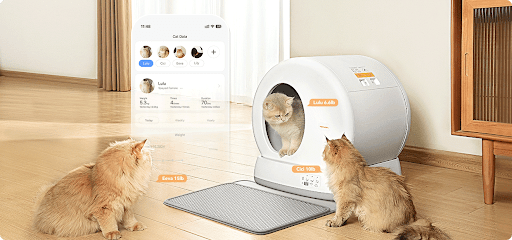Did you know that over 75% of cat behavioral issues stem from litter box problems? As cat owners, we often overlook crucial aspects of litter box management, leading to a cascade of challenges that affect both our pets and our homes. These preventable mistakes can result in cats avoiding their litter boxes, creating persistent odor issues, compromising home hygiene, and even causing serious health problems for our feline companions. While many new cat owners focus on food choices and playtime, proper litter box maintenance remains a frequently misunderstood aspect of cat care. The good news is that most common litter box problems can be easily resolved by understanding and correcting basic human errors. In this guide, we’ll explore practical solutions to transform your cat’s litter box experience from a potential source of stress into a comfortable, hygienic space that promotes healthy bathroom habits.
Understanding Cat Litter Box Fundamentals
Proper litter box maintenance is more than just a cleanliness issue – it’s fundamental to your cat’s physical and psychological well-being. Cats are naturally clean animals with strong territorial instincts that drive their bathroom behaviors. In the wild, cats carefully select and maintain their elimination spots to avoid attracting predators and establish territory boundaries. This natural behavior translates directly to their domestic environment, where the cat litter box becomes their designated territory for elimination. When this space doesn’t meet their instinctive needs, it can trigger stress, anxiety, and health issues like urinary tract infections or constipation. A proper litter box setup requires three essential components: appropriate size (1.5 times your cat’s length), suitable location (quiet, accessible, away from food), and consistent maintenance. Understanding these fundamentals helps create an environment that respects your cat’s natural instincts while promoting good bathroom habits. Think of the litter box as your cat’s personal bathroom – it deserves the same level of privacy, cleanliness, and accessibility you’d want in your own facilities.
Top 5 Litter Box Setup Mistakes
Wrong Box Selection Errors
Many cat owners underestimate the importance of proper litter box sizing, often choosing containers that are too small for their cats to move comfortably. The ideal box should be at least 1.5 times your cat’s length to allow natural turning and digging behaviors. While covered boxes might seem appealing for odor control, they can actually trap unpleasant smells inside and make cats feel cornered. High-sided boxes without a lowered entry point can pose accessibility challenges, especially for senior cats or kittens. When selecting a litter box, prioritize one with sturdy construction, smooth interior surfaces for easy cleaning, and adequate depth to prevent scatter. Many experienced cat owners recommend Meowant’s ergonomic litter boxes, which are designed with these specific feline needs in mind.

Poor Location Choices
Placing litter boxes in busy areas like laundry rooms or near noisy appliances can make cats too anxious to use them properly. Another common mistake is positioning boxes near food and water stations, which goes against cats’ natural instincts to eliminate away from their dining areas. In multi-level homes, failing to provide at least one box per floor forces cats to make inconvenient trips, potentially leading to accidents. Some owners hide boxes in dark corners or closets, making them difficult to access and clean regularly. The ideal location should be quiet, well-lit, easily accessible, and offer clear escape routes while maintaining privacy. Consider your cat’s daily routine and typical paths through your home when choosing box locations.
Cat Litter Box Maintenance Errors
Inadequate Cleaning Routines
One of the most critical mistakes in litter box maintenance is inconsistent cleaning schedules. While many owners believe daily scooping is sufficient, failing to remove waste within hours can lead to odor buildup and box avoidance. Another oversight is postponing complete litter changes, which should occur every 2-4 weeks depending on usage. Some owners inadvertently create health risks by using harsh cleaning products that leave residual chemicals cats find offensive or harmful. The misconception that strong-smelling cleaners better control odors often backfires, as cats are sensitive to artificial fragrances.

Litter Choice and Depth Issues
Selecting heavily scented litter products represents another common error, as most cats prefer unscented varieties that don’t interfere with their sensitive noses. Many owners also maintain insufficient litter depth – the ideal range is 2-3 inches for most cats, allowing natural digging behavior while preventing scatter. Tracking problems often result from using the wrong litter texture or failing to place appropriate mats around the box area. Different cats have distinct preferences for litter texture based on their past experiences and instinctive behaviors. Fine-grained litters might work well for one cat while causing discomfort for another, especially those with sensitive paws or previous negative experiences.
Behavioral Misinterpretations
Understanding your cat’s litter box behavior requires careful observation and interpretation. When cats avoid their litter boxes, they’re not being difficult – they’re communicating genuine concerns. Common signs of litter box aversion include eliminating near but not in the box, excessive scratching around the box area, or quick exits without proper covering of waste. These behaviors often indicate underlying issues like box cleanliness, location discomfort, or territorial stress. In multi-cat households, dominant cats may guard preferred litter boxes, forcing submissive cats to seek alternatives. Environmental stressors such as new pets, home renovations, or changes in routine can also trigger litter box avoidance. Rather than punishing these behaviors, focus on identifying and addressing the root cause. Watch for patterns in your cat’s behavior – do they avoid the box at specific times, or only after certain events? Are they showing other signs of stress like excessive grooming or hiding? By treating these behaviors as communication rather than misbehavior, you can better address your cat’s needs and restore proper litter box habits.
Step-by-Step Correction Guide
Immediate Fixes for Existing Problems
When faced with litter box issues, start with a thorough deep cleaning using enzyme-based cleaners to eliminate lingering odors. Remove the existing box and sanitize the surrounding area, including walls and floors. Begin location adjustments by identifying quiet spaces away from high-traffic areas, ensuring each spot offers multiple escape routes. For temporary solutions with rejected boxes, try placing an additional box in a new location while maintaining the original one, allowing your cat to choose their preferred spot. Consider using attractant products specifically designed to encourage proper litter box use.
Long-Term Maintenance System
Establish a consistent maintenance routine that includes twice-daily scooping, ideally morning and evening. Weekly tasks should include wiping down box exteriors and surrounding areas, plus checking litter depth to maintain the optimal 2-3 inches. Schedule monthly deep cleaning sessions where you completely empty, sanitize, and refill boxes with fresh litter. Create a digital or physical tracking system to monitor your cat’s bathroom habits, noting any changes in frequency or behavior that might indicate health issues. Set calendar reminders for regular maintenance tasks, and keep supplies readily available in a nearby storage solution. This systematic approach helps prevent future problems while making maintenance more manageable and consistent.
Creating a Positive Litter Box Environment
The journey to perfect litter box management begins with recognizing that most common issues stem from human oversight rather than cat misbehavior. By addressing the fundamental mistakes we’ve discussed – from improper box selection and placement to inadequate cleaning routines and misinterpreted behaviors – you can create an environment that supports your cat’s natural instincts and promotes healthy bathroom habits. Remember that your cat’s litter box needs are as important as their food, water, and affection requirements. The investment in proper litter box maintenance pays dividends in reduced stress, fewer accidents, and a stronger bond with your feline companion. Start today by implementing just one improvement from this guide, whether it’s relocating a box to a quieter area, establishing a consistent cleaning schedule, or upgrading to an appropriately sized container. Your cat will thank you with improved behavior, and you’ll enjoy a cleaner, more harmonious home environment. The power to prevent most litter box problems lies in your hands – use it wisely.

